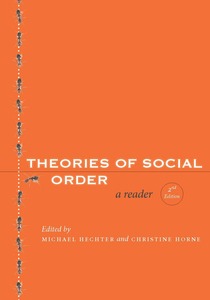Supplemental Readings
Networks
A contemporary version of the groups and networks approach focuses on the importance of social capital. Social capital and related concepts such as collective efficacy and cohesion are used to explain a range of social phenomena — educational outcomes, economic well-being, political vitality, crime, and so forth. The list of supplemental readings includes pieces focusing specifically on social capital, as well as other work relevant to the groups and networks approach more generally.
Bearman, Peter S., James Moody, and Katherine Stovel. 2004. “Chains of Affection: The Structure of Adolescent Romantic and Sexual Networks.” American Journal of Sociology 110(1):44-91.
Blau, Peter and Joseph Schwartz. 1997. Crosscutting Social Circles: Testing a Macrostructural Theory of Intergroup Relations. Transaction Publishers.
Burt, Ronald S. 2004. “Structural Holes and Good Ideas.” American Journal of Sociology 110:349-399.
Collins, Randall. 1998. The Sociology of Philosophies. Belknap Press.
An article from the New York Times explains that the American army has asked tribal leaders in the Sunni Triangle of Iraq to help them provide social order. However, after Saddam Hussein destroyed indirect rule — the network of tribal groups that was historically responsible for the maintenance of much social order in Iraq — tribal leaders no longer have the authority to control their members. Thus, they claim that they are unable to help.
http://www.nytimes.com/2003/11/11/international/middleeast/11FALL.html?ex=1069565839&ei=1&en=3e1e5cd32633703a
McPherson, Miller, Lynn Smith-Lovin, and Matthew Brashears. 2006. “Social Isolation in America: Changes in Core Discussion Networks over Two Decades.” American Journal of Sociology 71(3):353-375.
Putnam, Robert. 2000. Bowling Alone. NY: Simon and Schuster. Pp. 18-24. Discussion of bridging and bonding social capital.
Varshney, Ashutosh. 2002. Ethnic Conflict and Civic Life. New Haven, Yale University Press. Provides evidence that cross-cutting ties foster social order by showing that Hindu/Muslim violence is minimized in Indian cities in which there is intergroup participation in voluntary associations, and maximized in Indian cities having segregated membership in voluntary associations.
Watts, Duncan. 2004. Six Degrees: The Science of a Connected Age. W.W. Norton.
